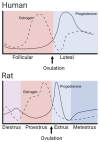Are There Prevalent Sex Differences in Psychostimulant Use Disorder? A Focus on the Potential Therapeutic Efficacy of Atypical Dopamine Uptake Inhibitors
- PMID: 37446929
- PMCID: PMC10343811
- DOI: 10.3390/molecules28135270
Are There Prevalent Sex Differences in Psychostimulant Use Disorder? A Focus on the Potential Therapeutic Efficacy of Atypical Dopamine Uptake Inhibitors
Abstract
Psychostimulant use disorders (PSUD) affect a growing number of men and women and exert sizable public health and economic burdens on our global society. Notably, there are some sex differences in the onset of dependence, relapse rates, and treatment success with PSUD observed in preclinical and clinical studies. The subtle sex differences observed in the behavioral aspects of PSUD may be associated with differences in the neurochemistry of the dopaminergic system between sexes. Preclinically, psychostimulants have been shown to increase synaptic dopamine (DA) levels and may downregulate the dopamine transporter (DAT). This effect is greatest in females during the high estradiol phase of the estrous cycle. Interestingly, women have been shown to be more likely to begin drug use at younger ages and report higher levels of desire to use cocaine than males. Even though there is currently no FDA-approved medication, modafinil, a DAT inhibitor approved for use in the treatment of narcolepsy and sleep disorders, has shown promise in the treatment of PSUD among specific populations of affected individuals. In this review, we highlight the therapeutic potential of modafinil and other atypical DAT inhibitors focusing on the lack of sex differences in the actions of these agents.
Keywords: DAT; cocaine; dopamine; modafinil.
Conflict of interest statement
The authors declare no conflict of interest.
Figures



Similar articles
-
Dual DAT and sigma receptor inhibitors attenuate cocaine effects on nucleus accumbens dopamine dynamics in rats.Eur J Neurosci. 2024 May;59(10):2436-2449. doi: 10.1111/ejn.16293. Epub 2024 Mar 5. Eur J Neurosci. 2024. PMID: 38444104 Free PMC article.
-
An FSCV Study on the Effects of Targeted Typical and Atypical DAT Inhibition on Dopamine Dynamics in the Nucleus Accumbens Shell of Male and Female Mice.ACS Chem Neurosci. 2023 Aug 2;14(15):2802-2810. doi: 10.1021/acschemneuro.3c00354. Epub 2023 Jul 19. ACS Chem Neurosci. 2023. PMID: 37466616 Free PMC article.
-
Psychostimulant Use Disorder, an Unmet Therapeutic Goal: Can Modafinil Narrow the Gap?Front Neurosci. 2021 May 26;15:656475. doi: 10.3389/fnins.2021.656475. eCollection 2021. Front Neurosci. 2021. PMID: 34121988 Free PMC article. Review.
-
R-modafinil (armodafinil): a unique dopamine uptake inhibitor and potential medication for psychostimulant abuse.Biol Psychiatry. 2012 Sep 1;72(5):405-13. doi: 10.1016/j.biopsych.2012.03.022. Epub 2012 Apr 25. Biol Psychiatry. 2012. PMID: 22537794 Free PMC article.
-
Modafinil and its structural analogs as atypical dopamine uptake inhibitors and potential medications for psychostimulant use disorder.Curr Opin Pharmacol. 2021 Feb;56:13-21. doi: 10.1016/j.coph.2020.07.007. Epub 2020 Sep 11. Curr Opin Pharmacol. 2021. PMID: 32927246 Free PMC article. Review.
Cited by
-
Dual DAT and sigma receptor inhibitors attenuate cocaine effects on nucleus accumbens dopamine dynamics in rats.Eur J Neurosci. 2024 May;59(10):2436-2449. doi: 10.1111/ejn.16293. Epub 2024 Mar 5. Eur J Neurosci. 2024. PMID: 38444104 Free PMC article.
-
Organic cation transporters in psychiatric and substance use disorders.Pharmacol Ther. 2024 Jan;253:108574. doi: 10.1016/j.pharmthera.2023.108574. Epub 2023 Dec 9. Pharmacol Ther. 2024. PMID: 38072333 Free PMC article. Review.
-
Potential therapeutics for effort-related motivational dysfunction: assessing novel atypical dopamine transport inhibitors.Neuropsychopharmacology. 2024 Jul;49(8):1309-1317. doi: 10.1038/s41386-024-01826-1. Epub 2024 Mar 1. Neuropsychopharmacology. 2024. PMID: 38429498 Free PMC article.
References
-
- UNODC . World Drug Report 2022. United Nations Publications; New York, NY, USA: 2022.
Publication types
MeSH terms
Substances
Grants and funding
LinkOut - more resources
Full Text Sources

